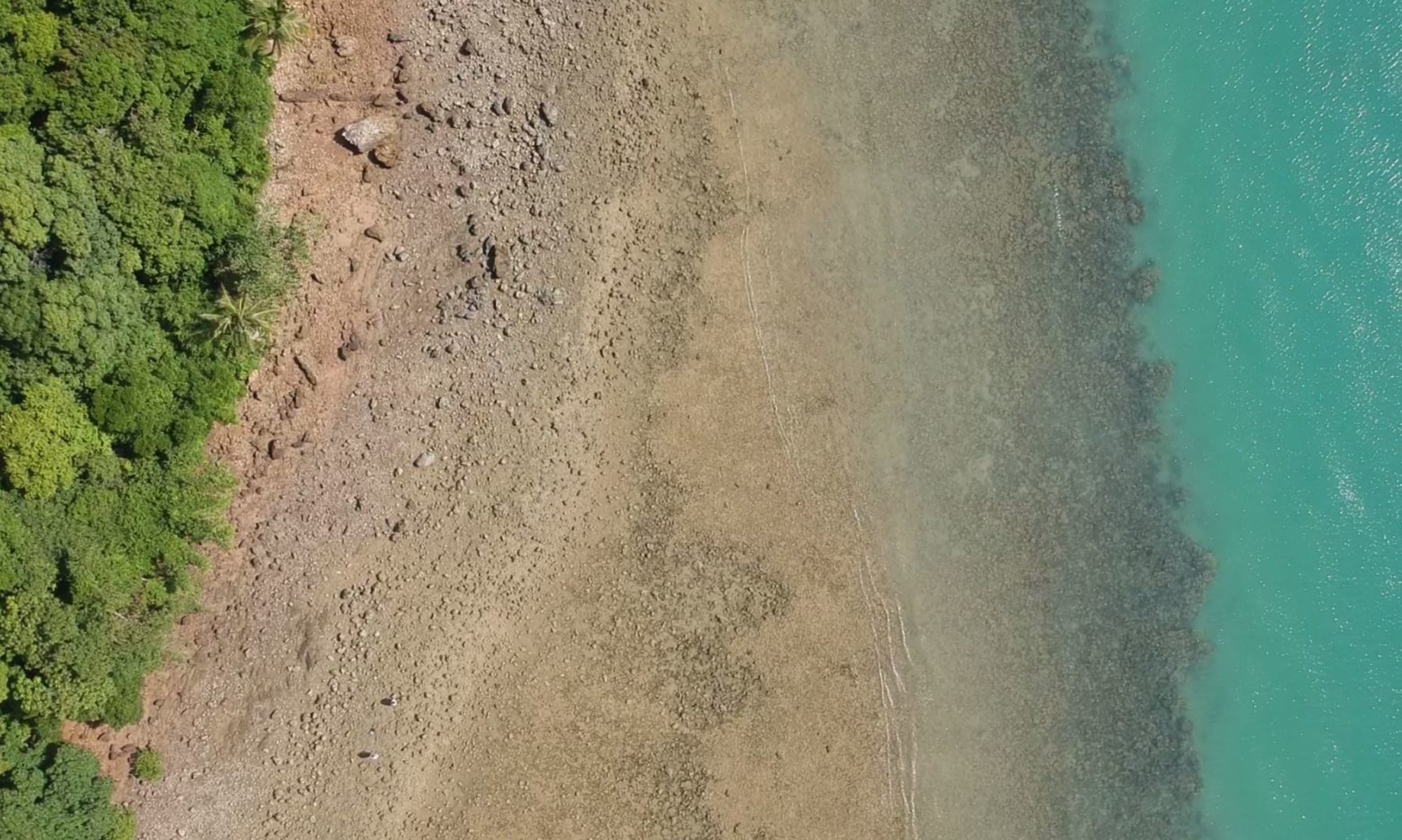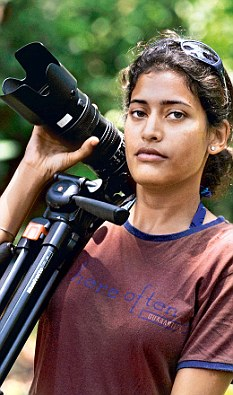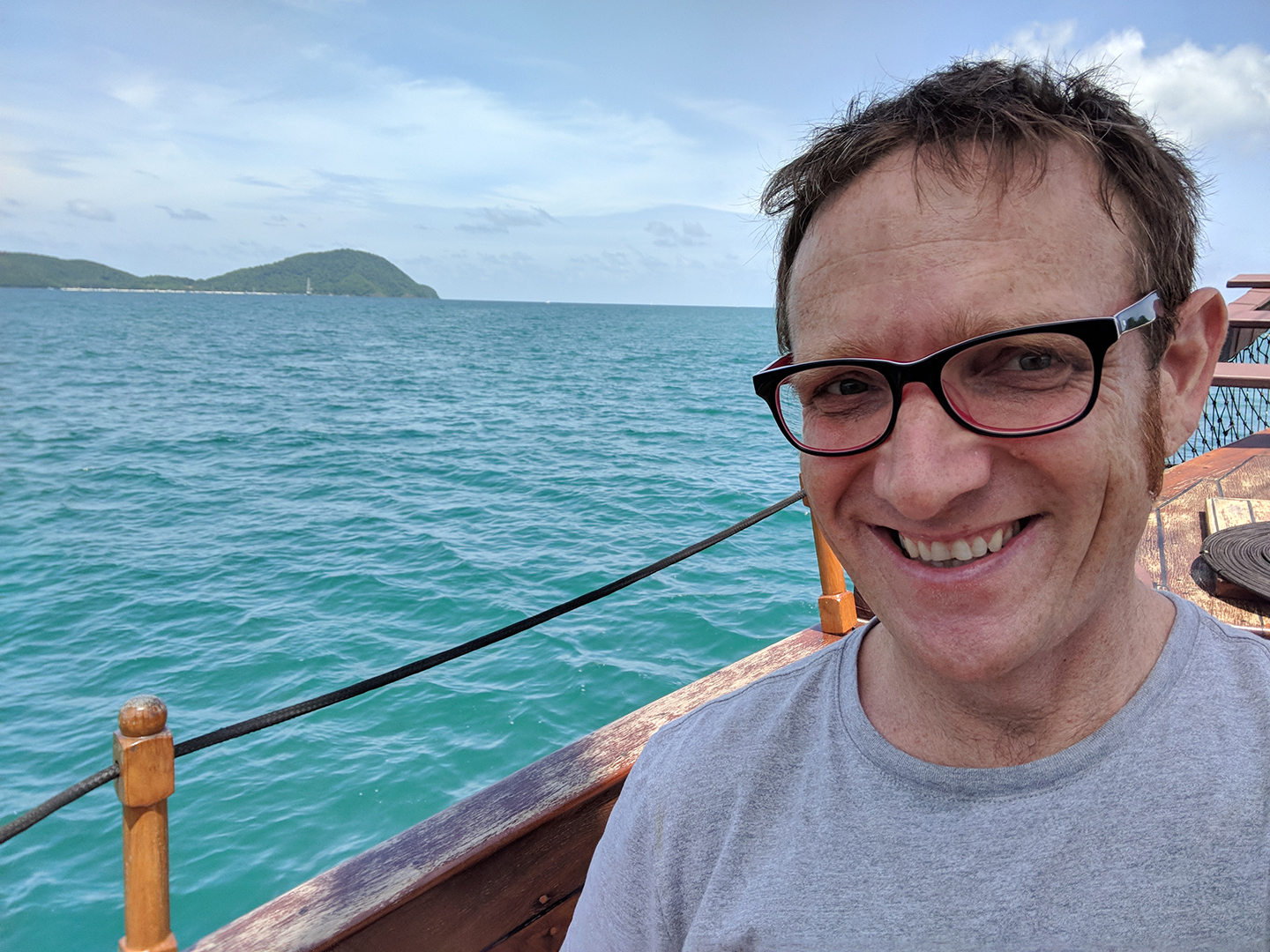Dr. Andrew Quitmeyer is a hacker adventurer studying intersections between wild animals and computational devices. He left his job as a tenure track professor at the National University of Singapore to start his own Field Station Makerspace in Gamboa Panama: Digital Naturalism Laboratories (dinalab.net). Here he blends biological fieldwork and DIY digital crafting with a community of scientists, artists, designers, and engineers from around the world. He runs mobile workshops called “Hiking Hacks” where participants build interactive technology in outdoor, natural contexts. The Digital Naturalism Conference (dinacon.org) is his research’s largest event, pulling in over 100 participants annually from all fields to collaborate on finding new ways of interacting with nature. His research also inspired a silly spin-off international television series he starred in for Discovery Networks called “Hacking the Wild.”
Tasneem Khan
Tasneem has spent the last decade facilitating interdisciplinary initiatives in the fields of ecology, conservation, education and science communication. Her formal training in marine zoology and practice in the development of experiential learning pedagogies was translated into active programs during the eight years spent as director of the Andaman and Nicobar islands Environmental Team. Tasneem’s photography and writing are visible across scientific and popular publications, book contributions and development of learning materials.
Beyond the scope of research and field based education, she believes that learning and working across subject boundaries is fundamental. Her participation in public speaking and leadership programs is an effort to explore these pathways.
Jessica Anderson
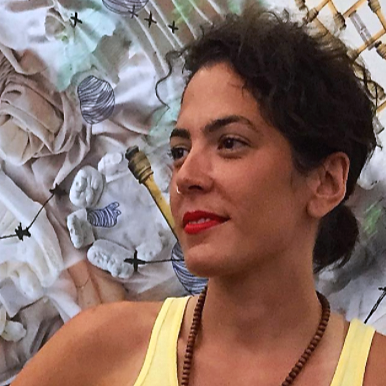
[June 17 – July 2]
I’m Jessica.
My partner Sebastian Monroy and I make digital art together.
Me: interaction design and building installations
He: programming and visual design
This project has evolved!
~ We are going to record the electrical activity in a variety of plants over longer (3-5 days) and shorter (1-12 hours) periods of time.
~ We’ll use the data to make generative art (hopefully in real time) using Unity, as if the plants are drawing.
~We’ll focus on large leaf vegetation.
~While the plants are drawing their art, I will draw the plants.
~ The project will end with the collection of generative art projection mapped onto the plants that generated them. It’ll be an illuminated forest experience.
WE INVITE OTHERS TO GET INVOLVED // HERE’S HOW
~ join my plant sketching sessions. I’ll be drawing the plants daily
~ If you’re great at biological drawing, or if your PRETTY OKAY at any kind of drawing, please lend your expertise! Host a plant sketching sesh and share your knowledge.
~ If you’ve measured plant electricity before, we’d love your input and help!
~ If you have specialized knowledge about how plants use electricity, please share! It will help a lot with creating meaningful visual designs.
~ If you’re a performance artist, are you interested in performing in the illuminated forest?
///////////////////////////////////////////////////////////////////////////////////////////////
We were inspired by @DrBeef on twitter //
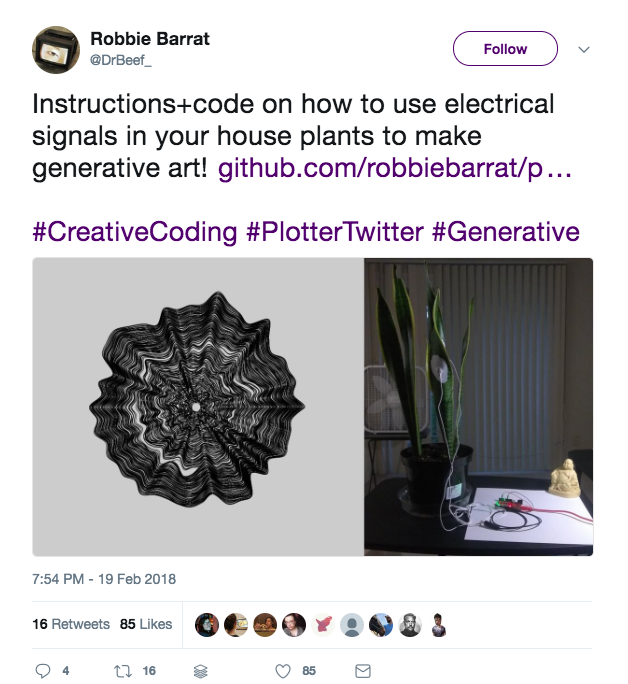
We’re inspired by the bio-diversity on the island, and how different tropical plants might express themselves differently or similarly to others in varying conditions.
To understand how to get the most accurate measurements, we’re going to try non-invasive extracellular recording using silver chloride treated electrodes or a method using medical electrodes like the kind used in EEG.
We're using this thread on electronics stackexchange to learn about how to measure the electricity from foliage. https://electronics.stackexchange.com/questions/85342/ detect-electrical-signals-from-plants
We're also using a paper by Jorg Fromm & Silke Lautner "Electrical signals and their physiological significance in plants" (2006) to learn about plant bioelectricity. https://onlinelibrary.wiley.com/doi/abs/10.1111/j.1365-3040.2006.01614.x
////////////////////////// We are going to use this data to generate graphic art using the Unity game engine. Here’s a peep at some of our generative artwork in Unity:
////////////////////////// TeamLab’s light projection onto trees inspires us.
Our goal is to project the digital art generated by the plant’s electricity back onto the plant itself — to show activity in the plant that is always happening, but unseen.
//////////////////////////////////////////////
EQUIPMENT LIST
~ Greenlee DM-510A True RMS Professional Plant Digital Multimeter
~ DTECH 10 Feet USB 2.0 to RS232 DB9 Serial Port Adapter Cable with FTDI (10′ wired connection for DMM to PC display — maybe a longer one? wireless?) ~ 4mm Ag/AgCl electrode discs ~ Spectra 360 Electrode Gel
//////////////////////////////////////////////
LET’S TALK! JESSICAXANDERSON@GMAIL.COM
David Bowen
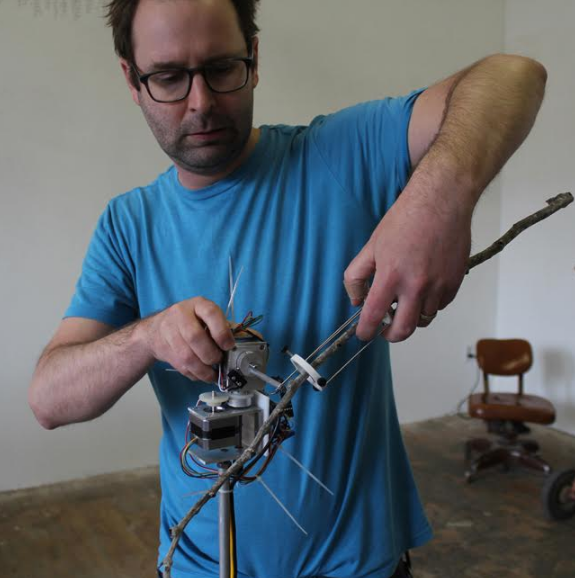 [June 02 – 14]
[June 02 – 14]
David Bowen is a studio artist and educator whose work has been featured in numerous group and solo exhibitions nationally and internationally. Bowen’s work consists of interactive, reactive and generative processes that emerge from intersections between natural and mechanical systems. He is currently an Associate Professor of Sculpture and Physical Computing at the University of Minnesota.
At the conference, he will produce a work that utilizes data obtained from this unique landscape and geographic location. Some examples of this include scanning the dynamic surface of the water, capturing the physical movements of objects caused by the wind or logging fluctuations in temperature and light conditions. This collected data will manifest itself in a physical sculptural object that will move, adapt to or emulate the natural phenomena observed.
FAQ – (dinacon 1)
Main Rules
Is it REALLY free?
Yes! hopefully free as in both pizza and freedom! We will cover your housing (you might need to bring a tent), and your registration. You have to figure out how to get here.
But i heard there is a deposit?
Yes! If your application is accepted we will notify you in February and have you pay a $20 USD deposit. We will refund your deposit when you arrive on the island! This is just to encourage people to actually come if they say they will, since there are other people on the waiting list.
What are “Ants”
Ants are super cool! and to help make sure people ACTUALLY READ this FAQ, if you see the word “Ants” in a form to guarantee that you have read the latest version of the FAQ, you should select that! (click “Ants” on the form to indicate “yes”).
What are the official “rules” of the conference?
1. You must complete something. Aim big, aim small, just figure out a task for yourself that you can commit yourself to that you can accomplish during your time at the conference. It can be any format you want: sculpture, a movie, a poem, a fingerpainting, a journal article – you just have to finish it!
2. You should document what you made and share it with our group at the conference (even if it means just sharing your article you wrote, or taking a photo of the thing). Everything will be made open-source and publicly accessible!
3. You need to provide feedback on two (2) other people’s projects.
4. You need to stay at the conference for at least two (2) consecutive nights.
Anything else?
Be nice to all humans and non-humans
Accomodations
Do I need to pack in all my own food?
Probably not! You can if you want! But there are frequent trips to the mainland, and we can stock up on food. There’s even a little restaurant at Baan Mai resorts.
Will I be able to bring my own tent/hammock and camp?
Yes! and it’s probably a great idea!
Is this going to be rough? Will i have to live outside in a deadly jungle the whole time?
We tried to set up our location to accomodate people of various adventurousnesses. It takes place at a tropical resort island, and you can choose your level of outdoorsy-ness for stay: live in a fancy cottage on the beach, stay in a ten on the lawn, or go live in the deep forest for the whole time.- it’s up to you!
What are the accommodations like?
They will be minimal. It will also be in the tropics which means hot, damp, full of biting things, and beautiful luxurious nature! Full description of our accommodations will be here: Location
Basically we can accommodate 10 people indoors, and 20 people camping style nearby. There are 2 extra cabins that people can rent as well if we don’t have enough room, or you want a private place to hang out! They aren’t too expensive.
Kids and Families
I have a child that is super amazing and brilliant, can I send them to your conference?
Sorry, this conference is meant for autonomous individuals and groups to interact with each other. Everyone is entirely responsible for themselves, and thus we can only admit persons 18 years old and up.
I have a family that I want to come with me (a person over 18 years old) which includes some members under 18. Can we come?
-Yes! You should register your group as a team, and note that you will be ENTIRELY responsible for not only yourselves but also any individuals under 18 that are in your care (i.e. I’m sorry to say we cannot provide any babysitting services).
Documentation
What’s this rule that everything has to be open-sourced and shared?
Being good scientists and technologists, we know that all work builds off the works of others. Therefore our goal is to expand humanity’s collective knowledge, and not limit it. For this reason, a key rule at our conference is that everyone’s projects have to be publicly shared.
I wanted to use the conference as a writing retreat to write articles, and get them reviewed in preparation for submitting to different journals or conferences. Won’t sharing my article prohibit me from publishing in these other places?
Nope, you can just share what you are working on as a “pre-publication” which is some sort of loophole that lots of these publishers don’t seem to mind!
What Types of Participants?
I don’t consider myself a field biologist, or an artist, or an engineer. Can I still come?
Totally of course! You can be whatever you want, no experience required, just have an interest in any aspects of these areas!
I’m a biologist, but I usually work in the laboratory, not in the field. Should I still try to come?
Totally of course! Take the cool things you know and do in the lab, and come try them out in the field with us!
I’m an artist without much experience in art or technology stuff, but i’m interested in exploring it more in the wild with you. Should I try to come?
-Totally of course! We will love combining your talents with all the other interesting stuff going on!
I’m an engineer working with computers or electronics, I’ve never been outside, but i want to try it out with you, should I come?
-(are you starting to notice a pattern) Totally of course!
I’m a jerk, and I’m real mean to people, and I don’t care about the environment, should I try to come?
-uhhhhgg i guess probably not?
Misc
Even though you are funding it with your own money, and trying really hard to provide a free, accessible space for all kinds of people, are some folks still going to get angry at you about different aspects of the conference.
Yep!
Won’t this conference involve people flying from all over the world, leading to the release of lots of greenhouse gases and increasing the toll on our earth?
Yeah. Unfortunately so like most other international conferences of academics. The longevity of the conference aims to help keep folks in place longer than most conferences though (where people zip in and out for a couple days). The eventual goal of this conference is to hopefully spawn lots of “Digital Naturalism” conferences in a similar style around the world, where people can rent out some land, and invite people to live and work on it in a more localized fashion.
—————–
And that’s it! This ensures that everyone going to the conference comes away with a finished project in hand, that has been reviewed by amazing experts you got to co-habitate with
Scott (Seamus) Kildall
Scott (Seamus) Kildall is a new media artist (www.kildall.com) who creates installations about how nature interacts with humans, including creating “voices for plants based on their electrical activity and synthesizers from on water quality.
